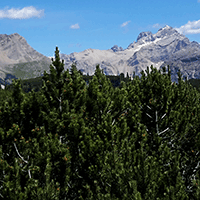
Effect of seedling stock on the early stand development and physiology of improved loblolly pine (Pinus taeda L.) seedlings
Shakuntala Sharma (1) , Joshua P Adams (2), Jamie L Schuler (3), Robert L Ficklin (4), Don C Bragg (5)
iForest - Biogeosciences and Forestry, Volume 9, Issue 5, Pages 690-695 (2016)
doi: https://doi.org/10.3832/ifor1725-009
Published: May 12, 2016 - Copyright © 2016 SISEF
Research Articles
Abstract
This study assessed the effects of spacing and genotype on the growth and physiology of improved loblolly pine (Pinus taeda L.) seedlings from three distinct genotypes planted in Drew County, Arkansas (USA). Genotype had a significant effect on survival and height. Clone CF Var 1 showed greater height and survival compared to other seedlings. Genotype had significant effects on uniformity in height both years and ground line diameter (GLD) first year. However, genotype had no significant effects on leaf water potential and coefficient variation of leaf water potential. These growth and physiology should be further studied to assess potential genetic differences among seedlings and to determine if they can be identified early for improved growth at later ages.
Keywords
Loblolly Pine, Genotype, Leaf Water Potential, Coefficient of Variation
Authors’ Info
Authors’ address
University of Georgia, Warnell School of Forestry and Natural Resources, Athens, GA (USA)
Louisiana Tech University, School of Forest Resources, Ruston, LA (USA)
West Virginia University, Morgantown, WV (USA)
University of Arkansas at Monticello, Arkansas Forest Resources Center, Monticello, AR (USA)
USDA Forest Service, Southern Research Station, Monticello, AR (USA)
Corresponding author
Paper Info
Citation
Sharma S, Adams JP, Schuler JL, Ficklin RL, Bragg DC (2016). Effect of seedling stock on the early stand development and physiology of improved loblolly pine (Pinus taeda L.) seedlings. iForest 9: 690-695. - doi: 10.3832/ifor1725-009
Academic Editor
Alberto Santini
Paper history
Received: May 31, 2015
Accepted: Feb 22, 2016
First online: May 12, 2016
Publication Date: Oct 13, 2016
Publication Time: 2.67 months
Copyright Information
© SISEF - The Italian Society of Silviculture and Forest Ecology 2016
Open Access
This article is distributed under the terms of the Creative Commons Attribution-Non Commercial 4.0 International (https://creativecommons.org/licenses/by-nc/4.0/), which permits unrestricted use, distribution, and reproduction in any medium, provided you give appropriate credit to the original author(s) and the source, provide a link to the Creative Commons license, and indicate if changes were made.
Web Metrics
Breakdown by View Type
Article Usage
Total Article Views: 46597
(from publication date up to now)
Breakdown by View Type
HTML Page Views: 39865
Abstract Page Views: 2472
PDF Downloads: 3106
Citation/Reference Downloads: 33
XML Downloads: 1121
Web Metrics
Days since publication: 3520
Overall contacts: 46597
Avg. contacts per week: 92.66
Citation Metrics
Article Citations
Article citations are based on data periodically collected from the Clarivate Web of Science web site
(last update: Mar 2025)
Total number of cites (since 2016): 1
Average cites per year: 0.10
Publication Metrics
by Dimensions ©
Articles citing this article
List of the papers citing this article based on CrossRef Cited-by.
References
Leaf area and above- and belowground growth responses of loblolly pine to nutrient and water additions. Forest Science 44: 317-328.
Gscholar
Plant breeding for water-limited environments. Springer, New York, NY, USA, pp. 14.
Gscholar
Response of planted longleaf pine bare-root and container stock to site preparation and release: fifth-year results. General Technical Report SO no.110, Southern Forest Experiment Station, USDA Forest Service, Asheville, NC, USA, pp. 165-168.
Gscholar
Survival and growth of container and bareroot shortleaf pine seedlings in Missouri. In: Proceedings of the “2006 National Meeting of the Forest and Conservation Nursery Associations” (Riley, LE, Dumroese RK, Landis TD eds). Proc. RMRS-P-43, Rocky Mountain Research Station, USDA Forest Service, Fort Collins, CO, USA, pp. 123-126.
Online | Gscholar
Soil survey of Drew County, Arkansas. USDA Soil Conservation Service and the Arkansas Agricultural Experiment Station, AR, USA, pp. 86.
Gscholar
Effects of cultural intensity and planting density on stand-level abovegroung biomass production and allocation for 12-year-old Loblolly pine plantations in the upper coastal plain and piedmont of the southern United States. Canadian Journal of Forest Research 42 (1): 111-122.
CrossRef | Gscholar

















